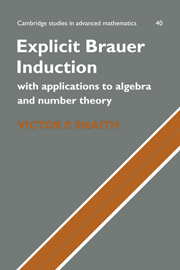4 - The class-group of a group-ring
Published online by Cambridge University Press: 12 January 2010
Summary
Introduction
Section 1 shows how Adams operations, ψk, behave with respect to Explicit Brauer Induction. In particular it is proved that one may express ψk(V) as an integral linear combination of monomial representations (i.e. induced from one-dimensional characters of subgroups) by applying ψk to each one-dimensional subhomomorphism in the Explicit Brauer Induction formula for V and then mapping the result to the representation ring, R(G). This result holds for all the Explicit Brauer Induction formulae, since it depends mainly on the naturality property. The effect of this result is to give one a form of Brauer's theorem which ‘commutes with Adams operations’. This result, which was first proved in Snaith (1989a) using the results of Snaith (1988b), is very convenient and rather unexpected and the remainder of this chapter consists of implications of this result.
In Section 2 we describe the adèlic Home-description of Fröhlich, which gives the class-group of an integral group-ring of a finite group in terms of groups of Galois-equivariant functions from R(G) to the idèles of a suitably large number field. Those who are familiar with algebraic K-theory will recognise the Hom-description as being equivalent to the exact K-theory sequence (at dimension zero) which was first obtained by C.T.C. Wall by applying algebraic K-theory to the canonical adèlic fibre square of group-rings. As an example, the Swan modules are introduced and their classes in the class-group are expressed in terms of the Hom-description and from this we prove the well-known result that for cyclic and dihedral groups the class of a Swan module is trivial.
- Type
- Chapter
- Information
- Explicit Brauer InductionWith Applications to Algebra and Number Theory, pp. 106 - 169Publisher: Cambridge University PressPrint publication year: 1994

